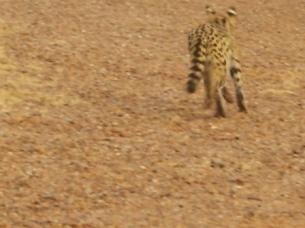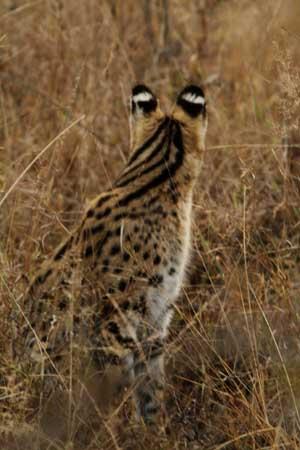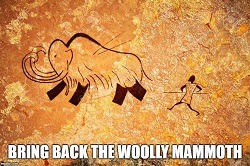



 The Accurate Reloading Forums
The Accurate Reloading Forums  THE ACCURATE RELOADING.COM FORUMS
THE ACCURATE RELOADING.COM FORUMS  Hunting
Hunting  American Big Game Hunting
American Big Game Hunting  And now...Ocelot Sighted
And now...Ocelot SightedGo  | New  | Find  | Notify  | Tools  | Reply  |  |
| one of us |
Arizona Game and Fish confirmed an ocelot sighting today in southeastern Arizona. Several images and tracks found by a Game and Fish helped verify the reported sighting. In a statement from Game and Fish, chairman Robert R. Woodhouse said the department will share the physical evidence with other ocelot experts for an independent analysis. This is the third sighting of the rare wild cat in Arizona this year. In February and May, sightings were reported in the Huachuca Mountains. It is not known if the same cat was seen in both incidents. This latest sighting comes on the heels of the recent sighting of a jaguar last week in Cochise County. ****** Game and Fish verifies ocelot sighting in Cochise County The Arizona Game and Fish Department announced Dec. 2 that it has verified a highly probable ocelot sighting in Cochise County that occurred this morning. Photos (including the one pictured) of the sighting were provided to the department by a homeowner around 8:30 a.m. today. Verification of the sighting included paw prints at the scene. Game and Fish will share the image with other ocelot experts for an independent analysis to attempt to definitively determine if it is an ocelot, hybrid or other large cat, as well as compare it to photos from previous sightings to determine if it is the same or a different animal from those sightings. An ocelot was photographed in Cochise County twice this year and was identified as probably the same animal. “We’re excited to see the continued presence of ocelots in Arizona and are anxious to see what analysis of this new photo tells us,” said Eric Gardner, nongame branch chief for Arizona Game and Fish. “The more photos we can obtain and the clearer they are, the better opportunity we’ll have to learn more about ocelot prevalence in our state.” An ocelot in Cochise County was photographed by the Sky Island Alliance in 2009, but comparative analysis wasn’t possible due to the quality of the photo. Another ocelot was found dead by the side of a road near Globe in 2010. The ocelot is listed as endangered under the U.S. Endangered Species Act. Tony Mandile - Author "How To Hunt Coues Deer" | ||
|
| one of us |
Global warming, everything is moving north! Or is it another illegal comeing to the promised land. The Wyoming G&F would have both shot, not native wildlife. They have tried their darndest to wipe the non-native naturally occuring whitetail. Yet propagate non-native turkeys, pheasants and wolves! | |||
|
| One of Us |
Ocelots wandering north into Arizona are not a recent occurrence, it's the "confirmed" sightings that are new. While in college in the late 1950s, while calling coyotes with a varmint call north of Tucson, I brought in what I later identified as an ocelot. It would have been legal to shoot it then, but I never got a shot. A couple of years later, when I told a wildlife manager about what I'd seen, his reaction indicated he didn't believe me. Roadkills and photos are hard proof that a rare animal is in an area. Sightings by "non-professionals" are too often not accepted. Bill Quimby | |||
|
| One of Us |
Hey Kudu, I mentioned to the G&F director that we ought to put whitetails on the predator list so our mule deer can recover. Nationally, whitetails are not going to be an endangered species, so maybe they should be here in Wyoming. I like mule deer much better. Just my opinion... "It ain't lion hunting unless you get stitches." - John in WYO "It became aquatic, briefly." Ann ~ Aspen Hill Adventures The bear has to touch you to hurt you. Don’t let the bear touch you. | |||
|
| One of Us |
Wasn't an ocelot like the other two legit sightings . Someone either released or lost their "pet" serval. KOLD news here in town had it on the news today. The reporting party had taken pics. It was clearly NOT an ocelot. It was a case of the media jumping the gun to have another rare cat sighting story. | |||
|
| one of us |
Agreed! I did some searching Sun. and found a photo of a serval from the rear. It looks exactly like one of the photos of the "ocelot." The back of the ears are the tipoff. Supposed ocelot:  Serval from the rear:  After further review, the Arizona Game and Fish Department said the reported rare sighting of an ocelot was another breed of cat called a serval. A serval is a popular African cat in the pet trade, the fish and game department said. The Department uses a three-tiered classification system to rank reported sightings from the public based on the level of physical evidence available, the department said. The presence of physical evidence such as scat, hair, tracks and/or photos and video can lead to a Class I designation of "verifiable" or "highly probable." A second-tier classification is one that lacks physical evidence, but is considered "probable" or "possible" because the sighting was made by an experienced or reliable observer that usually has wildlife or field experience. The third tier classification is one that does not have sufficient physical evidence or sufficient details, or is otherwise of questionable reliability and would be considered "highly unlikely" or "rejected" as evidence for occurrence. Friday's report of an ocelot was classified as "highly probable" based on the photos and the paw prints taken at the location of the sighting. The officer responding was unable to locate the animal or retrieve additional physical evidence such as hair or scat. Game and Fish shared the photographs with department biologists and other ocelot experts for an independent analysis. The effort helped definitively determine if it was an ocelot, hybrid or other large cat, as well as compare it to photos from previous sightings to determine if it is the same or a different animal from those sightings. "Upon closer examination, some key identification markers make a stronger case for this being a serval, or serval hybrid rather than an ocelot," said Eric Gardner, Nongame Branch Chief. "Although the pictures are blurry, two show that the animal has long ears, long legs, and appears to display only solid spots instead of the combination of solid spots and haloed rosettes seen on an ocelot." "This is a textbook example of why the Department attempts to makes such a clear distinction between a report of any rare wildlife sighting versus one with properly examined physical evidence. Positive identification by species experts or genetic analysis is required before any report is entered into our Heritage Data Management System as confirmed. It appears that this one may go down as ‘close but no cigar'" Gardner said. There have been only two sightings of an ocelot in Arizona this year. Tony Mandile - Author "How To Hunt Coues Deer" | |||
|
| one of us |
Your better trappers for years have purchased Ocelots put them in a wire cage with a wire floor, put a pan under the cage and put Coyote turds in the pan, along with the pan catching the Ocelot turds, then the Ocelot urinates on the feces and and the trapper put those turds in a plastic bag and used them for bait and they could be used over and over, and he could sell them at high prices.. This is the best coyote bait ever..place one of those turds on the off side of a trap set on a bald knob, and no coyote can refuse them. I suggest that perhaps on rare ocassions the Ocelots have escaped, or perhaps released for one reason or the other.. I know a few got loose in Texas back in the 1970s and some were released when the price of fur took that big nose dive.. Ray Atkinson Atkinson Hunting Adventures 10 Ward Lane, Filer, Idaho, 83328 208-731-4120 rayatkinsonhunting@gmail.com | |||
|
| one of us |
Always thought you might be an expert on turds. Tony Mandile - Author "How To Hunt Coues Deer" | |||
|
| One of Us |
Ray has taken his shit talking to another level *that is a joke* | |||
|
| One of Us |
That could also be a 'savannah cat', a domestic breed created using Serval males with domestic females. The F5's are considered a true domestic but look very much like a serval. I have an F3 bengal, she looks as exotic as you can get.  ~Ann  | |||
|
| one of us |
Ann, Doesn't appear the patterns are similar. The supposed "ocelot" and the serval has small spots -- rosettes -- on its side rather than the splotchy pattern in the photo you posted. Perhaps the patterns for those hybrides you cited sometimes come out quite different? Tony Mandile - Author "How To Hunt Coues Deer" | |||
|
| One of Us |
Tony, Mine is actually a different cross. Her breed is the result of an Asian Leopard Cat male X domestic female. If you google savannah cat and select images you will see what I am talking about. The savannahs are huge and look very much like a true serval. ~Ann  | |||
|
| one of us |
Ann, Aaaha, I see what you mean. I found a bunch of photos of the savannah cat and many of them are similar to both photos in my earlier message. So you could be right on with your guess. Tony Mandile - Author "How To Hunt Coues Deer" | |||
|
one of us |
Ann, You might try saving it's poop! Maybe you can catch a Yote/Mt Lion/Chupacabra/Yeti F5 cross! Put it on a bald knob with some ice cream and jack links jerky, they can't resist it! | |||
|
| One of Us |
I am not much for cats,but that one is cool!!! | |||
|
| Powered by Social Strata |
| Please Wait. Your request is being processed... |
|
 The Accurate Reloading Forums
The Accurate Reloading Forums  THE ACCURATE RELOADING.COM FORUMS
THE ACCURATE RELOADING.COM FORUMS  Hunting
Hunting  American Big Game Hunting
American Big Game Hunting  And now...Ocelot Sighted
And now...Ocelot Sighted

Visit our on-line store for AR Memorabilia

